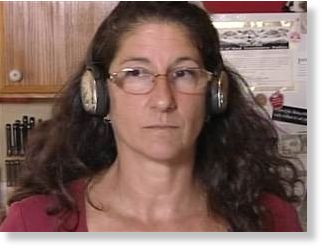"The fear is that I won't control the rage," Siganoff told TODAY's Mara Schiavocampo. "It's huge. It's physical. It's everything I have turns into a boiling pot of rage. And then I have to talk myself down because this isn't the way you're supposed to live."
Whether it's finger nails scraped across a blackboard or the sound of someone slurping up soup, there are noises that annoy all of us, sounds that just seem to get under our skins. But that reaction pales in comparison to what people like Adah feel. For them, the reaction is instantaneous and intense. It feels like their whole bodies are exploding in reaction to this horrible sound.
Adah and others like her suffer from a little-known condition that has recently been dubbed misophonia by the few experts who have begun to look into it.
"It's all about the reaction," Siganoff explained. "The rage. The anger. Not being able to stop it. For people with this disorder, the sound is like 200 people pulling their fingernails down a chalkboard at the same time. It's that same intensity and it's very overwhelming."
An article in The New York Times earlier this week may have been the first time most Americans heard of the strange and mysterious condition. The new attention has been a relief to people like Adah and Heidi Salerno, who says she has felt isolated for years by her inexplicable symptoms.
"It's just like a weight has lifted off you," she told TODAY's Ann Curry. "Because I have had this since I was about 8 or 10. We older patients have lived our lives completely isolated, believing that we were the only person with this issue and not knowing that other people have had it. Thank goodness for the internet."

"There's just the feeling that, 'my God, I'm crazy,'" Salerno told Curry. "Why can't I be like everybody else? Why can't I brush it off? Why can't I ignore it? It's really troublesome."
The internet was where Siganoff, too, found answers. It's also where she discovered there were support groups for people suffering from misophonia.
She'd spent many years in therapy trying to deal with what had been mistakenly diagnosed as post-traumatic stress syndrome, or PTSD. With no signs of improvement, she was desperate.
So one day Siganoff Googled the phrase: "I hate eating sounds." A few keystrokes later she'd hooked up with a support group run by Oregon audiologist Dr. Marsha Johnson. Johnson describes the intensity of what people with misophonia feel this way: "What they experience is a sort of Mount St. Helens eruption of emotions and feelings associated with these sounds."
Johnson started her group in an effort to reach out to people who felt totally alone.
"They're fairly isolated from one another and when they go around the community looking for help they're often just turned down left and right by the medical providers," she said. "The medical providers have never seen another case like this. And they don't know what to make of it."
Right now no one knows exactly what causes the intense reactions to the common sounds that most of us are able to block out.
Dr. Roshini Raj suspects it's faulty brain wiring. "There's probably something going on in the way the brain is processing the sound that is affecting their limbic - or emotional - systems," she told TODAY.
"Unfortunately right now we don't have a lot of treatments. And honestly, many doctors don't recognize it as a condition. We're learning more about it every day. But someone needs to study these patients to find why it's going on and what we can do about it."
Until that happens, people like Adah and Heidi will continue to depend on their own coping mechanisms, like eating alone or screaming to release tension. Ultimately, though, it means a lot to them to see that the medical community might finally be taking their problem seriously.
"The truth is I didn't choose this," Adah said. "I can't think my way out of it. We need help. And it's happening."
Linda Carroll is a health and science writer living in New Jersey. Her work has appeared in The New York Times, Newsday, Health magazine and SmartMoney. She is the co-author of the forthcoming book The Concussion Crisis: Anatomy of a Silent Epidemic.



Could be a vagus nerve problem too since it seems to turn on the sympathetic nervous system. Perhaps doing the Eiriu Eolas program would help?